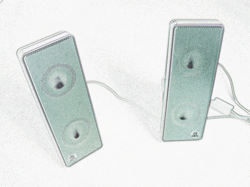Active Loudspeaker Systems
Applications
- Home
- Automotive
- Multimedia
- Professional
- Telecommunication
Particularities
Active loudspeaker systems use an internal power amplifier and additional analogue and digital electronics for digital audio streaming, DA conversion, limiting, crossover, gain attenuation and loudspeaker control (protection and linearization). The electrical terminals of the transducers (e.g. tweeter and woofer) are usually not accessible for the assessment of the final product.
Therefore, the evaluation of an active loudspeaker system has only access to mechanical or acoustical output signal monitored by using a microphone or a laser sensor. Contrary to drive units and passive loudspeaker systems, the nonlinearities cannot be measured directly by using a nonlinear system identification technique. However, measurement of harmonic and intermodulation distortion and other meaningful nonlinear symptoms (e.g. dc displacement) may give meaningful indications about the physical cause. Small leakages in the enclosure generating audible air noise can reliably be detected by using a sensitive noise demodulation technique.
Parasitic vibration of the grill, handle or any other part of the enclosure may cause impulsive distortion similar to the irregular Rub & Buzz defects found in the drive unit. The sound pressure response on-axis and off-axis, sound power response and other directivity characteristics can be measured in the near field under arbitrary conditions or in the far field under anechoic conditions.
The acoustical characteristics can also be predicted by FEA and BEA using the mechanical distributed parameters of the loudspeaker drive units measured by laser the scanning technique and the geometry of the enclosure. Measurements of the fundamental response at multiple input levels reveal the compression of the fundamental and distortion components caused by nonlinearities and the heating of the voice coil. This data may be used to predict the voice coil temperature and to define the maximal sound pressure output for different stimuli.
Challenges in the Design
- Optimal selection of drive units (woofer, tweeter)
- Optimal design of the vented enclosure (alignment, port noise)
- Crossover design and time alignment
- Thermal power handling
- Thermal and mechanical protection
- Additional equalization
- Rub & Buzz, vibration of the grill, air leakage noise
Most Important Characteristics
- Maximal short-term sound pressure level (SPL) in stated frequency band (1s, 1m, on-axis)
- Maximal long-term SPL in stated frequency band (1 min, 1m, on-axis)
- Harmonic distortion at short-term maximal SPL in stated band
- Intermodulation distortion at maximal short-term SPL in stated band
- Impulsive distortion (Rub & Buzz) at maximal short-term SPL in stated band
- Small signal sound pressure frequency response (magnitude and group delay at 1m, on-axis)
- Sound power response or directivity index
Critical Issues
- Rub & Buzz, loose partials in the drive unit
- Parasitic vibration of the grill
- Air leakage noise
- Hard limiting of the suspension (large values of weighted harmonics HI-2 distortion)
- Excessive modulation distortion (motor instability, Bl(x) and L(x) asymmetries)
- Acoustical cancellation effects (negative directivity index)
Accessories
Standards
Audio Engineering Society
AES2 Recommended practice Specification of Loudspeaker Components Used in Professional Audio and Sound Reinforcement
AES56 Standard on acoustics – Sound source modeling – Loudspeaker polar radiation measurement
Consumer Electronics Association
CEA-CEB19 Recommended Loudspeaker Safety Practices
CEA-2006-A Testing & Measurement Methods for Mobile Audio Amplifiers
CEA-2019 Testing and Measurement Methods for Audio Amplifiers
CEA-2031 Testing and Measurement Methods for Mobile Loudspeaker Systems
CEA-2034 Standard Method of Measurement for In -Home Loudspeakers
International Electrotechnical Commission
IEC 60268-5 Sound System Equipment, Part 5: Loudspeakers
IEC 62458 Sound System Equipment – Electro-acoustic Transducers - Measurement of Large Signal Parameters
Institute of Electrical and Electronics Engineers
IEEE 269 Standard Methods for Measuring Transmission Performance of Analog and Digital telephone Sets, Handsets, and Headsets
IEEE 1329 Standard Method for Measuring Transmission Performance of Speakerphones
IEEE 1652 Standard for the Application of Free Field Acoustic Reference to Telephony Measurements
International Telecommunication Union
ITU-R Recommendation BS. 775-2: Multi-channel stereophonic sound system with and without accompanying picture
ITU-R Recommendation BS. 1116: Method for subjective assessment of small impairments in audio systems including mulitchannel sound systems

